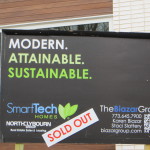Pilsen – The Gentrification Frontier
On the night of January 22-23, 2015, the windows of Bow Truss Coffee at 1641 West 18th Street on Chicago’s Lower West Side were covered with handwritten posters declaring “Wake up and smell the gentrification … ¿Sabes dondes estas? ¡La raza vive aqui! … Sugar with your gentrification?” An artisanal coffee roaster that has two other locations in the city, Bow Truss had opened on 18th Street a few months previously in summer 2014. To many residents of this Pilsen neighborhood, the arrival of Bow Truss and its gourmet coffee, priced at more than double that sold at Dunkin Donuts on the same block, symbolized what had long been feared: gentrification was fundamentally changing their community, remaking it into a place where they could no longer afford to live.
Chicago’s Pilsen neighborhood is a fascinating case study in urban geography. It has some of the oldest housing in Chicago, much of it below street level as buildings date back to a time before the city was raised above the water levels of Lake Michigan and its surrounding wetlands. Located just over two miles southwest of the downtown Loop and largely built in the 1870s-1890s by Eastern European immigrants, from whom the neighborhood took the Anglicized ‘Pilsen’ after the Czech city of Plzeň, since the 1950s Pilsen has become known as one of Chicago’s most vibrant Hispanic neighborhoods. Populated primarily by Mexican-Americans and Mexican immigrants, as well as others of Central and South American descent, Pilsen for much of the past fifty years has been a low income neighborhood of bodegas, cheap tacos, tamales sold by street vendors, and low rents. Brass discs representing Mayan calendars are embedded in Pilsen’s sidewalks; the eagle and snake from Mexico’s flag is displayed on lamp posts along 18th Street; and, Aztec-inspired tiling adorns Rudy Lozano library, named after a respected local activist who was shot and killed in the early-1980s.



A port of entry for immigrants to Chicago for almost 150 years, Pilsen in the 21st Century is changing. For much of the past two decades, Pilsen has seen old factory buildings converted into condominium lofts (for example, Chantico Lofts at 1061 W. 16th Street), small nineteenth century cottages torn down and replaced by 3 or 4 unit condominiums which tower over adjacent properties (e.g. 953 West 18th Street). Newly built houses, offering lifestyles that are “modern, attainable, sustainable,” now sell for over half a million dollars (e.g. 1808 S. Morgan) and properties assessed as “contributing” to Pilsen’s successful 2005 application to be designated as a National Historic Landmark District have been demolished and replaced by duplexes with rooftop penthouses (e.g. 1111 West 16th Street). Added to this real estate development has been the closing of neighborhood favorites like the folk music performance space Decima Musa in 2012, and the renovation and reopening in 2013 of the historic Thalia Hall theater (1807 S. Allport St.), as an alternative rock venue and restaurant where patrons can enjoy music and, as detailed on its website, “The brine of fresh-shucked shellfish meeting the toast of a Dry Stout, the salted smoke of cured meat balanced by the fruit esthers of a Belgian Dubbel, the complex spice of Vietnamese clay pot fish quenched by a crisp Pilsner.”
In Pilsen today, there are two neighborhoods in one. Immigrant families struggle to meet rising rents and Hispanic-owned businesses seek to retain their Spanish-speaking clientele, while brew pubs and bars selling craft beers and award-winning tater tots cater to a more footloose, younger, and wealthier population intrigued by the neighborhood’s artistic reputation, its proximity to downtown, and hipster appeal. Murals of the Virgen de Guadalupe sit uncomfortably alongside stores selling handmade leather goods for hundreds of dollars and trendy boutiques offering vintage clothing styles. At Bow Truss in January, these divisions along the gentrification frontier came into stark relief. The owner, 35-year old Phil Tadros lamented in the Chicago Tribune, “It’s hard for me to believe we’ve done something bad… Who doesn’t want a good cup of coffee?” The poster he tore down, in contrast declared, “Racism and classism smelllls like your coffee.”
Euan Hague will lead a walking tour of Pilsen on Wednesday, April 22, 2-5 p.m.
—Euan Hague
DePaul University


